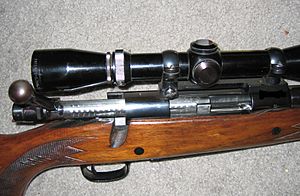Repeating rifle facts for kids
A repeating rifle is a special type of rifle that can fire many shots without needing to be reloaded after each one. Imagine a regular rifle where you have to put a new bullet in every time you shoot. A repeating rifle is much faster! It holds several cartridges (bullets) inside a special container called a magazine. After you fire, a part of the gun called a bolt moves a new bullet from the magazine into the firing spot, called the chamber. This action also gets the gun ready to fire again.
When people talk about "repeating rifles," they usually mean ones you operate by hand, like lever-action, pump-action, or bolt-action rifles. There are also "self-loading rifles" (sometimes called semi-automatic), which use the gun's own power from the last shot to load the next bullet. Even though self-loading rifles are technically repeating firearms, the term "repeating rifle" often points to the manual types.
Repeating rifles were a huge step forward in military battles. They let soldiers shoot much faster than older, single-shot rifles. For example, the Spencer rifle was used by soldiers on horseback during the American Civil War. The very first repeating air rifle used by an army was the Windbüchse rifle.
Contents
How Repeating Rifles Work
Repeating rifles use different ways to load new bullets. Here are some of the main types:
Manual Actions
These rifles require the shooter to do something by hand to load the next shot.
Revolver Action
Some early long guns used the same spinning cylinder idea as revolver handguns. While this worked well for pistols, it was tricky for rifles. When fired from the shoulder, gas could escape from the side of the cylinder, which was too close to the shooter's face. Because of this, revolver rifles didn't become very popular.
Falling Block Action
Most falling-block guns fired only one shot at a time. However, a few early repeating rifles used this design. Two famous examples are the Norwegian Krag–Petersson and the American Spencer rifle. The Krag-Petersson loaded bullets from a tube under the barrel, while the Spencer stored them in a tube inside the gun's stock (the part you hold against your shoulder).
Lever Action
In a classic lever-action rifle, like the famous Winchester Model 1873, bullets are stored in a tube under the barrel. To load a new bullet, you pull down a lever that is part of the trigger guard. This lever moves the bolt, ejects the empty shell, and a spring pushes a fresh bullet into place. When you push the lever back up, the new bullet goes into the chamber, and the gun is ready to fire. Later lever-action designs, like those from Marlin, could also use a box magazine, which allowed them to use bullets with pointed tips.
An unusual example of a lever action on an automatic gun was the M1895 Colt–Browning machine gun. It had a lever under the barrel that swung down each time it fired, earning it the nickname "potato digger."
Pump Action
With a pump-action rifle, you move a sliding part under the barrel (the "fore-end") back and forth. This motion ejects the used bullet and loads a new one. Pump actions are most common on shotguns, but rifles like the Remington Model 7600 series use this system. These rifles are also called slide-action rifles. Police officers sometimes use them because they are similar to pump shotguns, which many officers already know how to use.
Bolt Action
A bolt-action rifle uses a handle (the "bolt handle") that you operate by hand. To load a new bullet, you lift the handle, pull the bolt back to remove the empty shell, and then push the bolt forward to load a fresh bullet from the magazine. Finally, you push the handle down to lock the bolt in place, making the gun ready to fire. This action also resets the firing pin.
The Mauser rifle from the late 1800s and early 1900s is the most famous bolt-action design. Many other bolt-action rifles, like the M1903 Springfield and the Karabiner 98 Kurz (Kar98k), were based on the Mauser. Other well-known bolt-action rifles include the Russian Mosin–Nagant and the British Lee–Enfield.
Autoloading Actions
These rifles use the energy from the fired bullet to load the next one automatically.
Blowback
In a blowback system, the bolt is not fully locked when the gun fires. To prevent it from opening too quickly, the bolt is usually heavy or has a spring that slows it down. In many small guns, the bullet fires while the bolt is still moving forward. The bolt only opens after this forward movement is stopped by the force of the shot. This system is simple and cheap to make, but it works best with smaller, less powerful bullets, so you often see it in machine pistols and submachine guns.
Recoil-Operated
In a recoil-operated gun, the barrel and the bolt are locked together when the gun fires. They both move backward a short distance. Then, they unlock, and the barrel moves forward while the bolt continues backward to eject the empty shell and load a new one. This system is common in many semi-automatic handguns, like the Colt M1911.
Gas-Operated
Most modern military rifles use a gas-operated system. When a bullet is fired, a small amount of the hot gas that pushes the bullet out of the barrel is redirected. This gas pushes a small piston, which then unlocks and moves the bolt. The bolt ejects the empty shell and, with the help of a spring, loads the next bullet. This makes the gun ready to fire again very quickly.
See also
- Repeating firearm
- Belton flintlock
- Cookson repeater
- Kalthoff repeater
- Nordenfelt Gun






